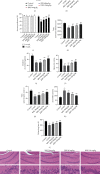Red Raspberry Extract Decreases Depression-Like Behavior in Rats by Modulating Neuroinflammation and Oxidative Stress
- PMID: 35818443
- PMCID: PMC9270999
- DOI: 10.1155/2022/9943598
Red Raspberry Extract Decreases Depression-Like Behavior in Rats by Modulating Neuroinflammation and Oxidative Stress
Retraction in
-
Retracted: Red Raspberry Extract Decreases Depression-Like Behavior in Rats by Modulating Neuroinflammation and Oxidative Stress.Biomed Res Int. 2023 Jun 21;2023:9792454. doi: 10.1155/2023/9792454. eCollection 2023. Biomed Res Int. 2023. PMID: 37388369 Free PMC article.
Abstract
Objective: Red raspberry serves as a proven natural product to produce anti-inflammatory, antioxidant, and anticancer functions, but limited findings are available on its effects on depression. This study, by using a chronic unpredictable mild stress- (CUMS-) induced depression model, thus investigated the effects and underlying mechanism of red raspberry extract (RRE) on depressive behavior, inflammation, and oxidative stress.
Methods: Different treatments were given after random grouping of Sprague-Dawley rats, including no intervention (control), CUMS induction, and CUMS+different concentrations of RRE, and subsequently, depression-like behavior tests were performed. HE staining was designed to observe the pathological damage of the hippocampal tissue in rats. The levels of oxidative stress, endocrine hormones, and inflammatory factors were determined by biochemical assay and ELISA, and gene expression (mRNA and protein) in the hippocampal tissue by qRT-PCR and Western blot.
Results: On completion of CUMS treatment, the rats showed severe depression-like behavior, with obvious hippocampal tissue damage, oxidative inflammatory response, and endocrine imbalance. Importantly, RRE treatment significantly improved such depression-like behavior and attenuated histopathological damage in CUMS rats when reducing inflammation and oxidative stress and endocrine imbalance with upregulation of glutathione (GSH), superoxide dismutase (SOD), and interleukin- (IL-) 10 and downregulation of adrenocorticotropic hormone (ACTH), corticosterone (CORT), malondialdehyde (MDA), IL-1β, cyclooxygenase- (COX-) 2, and human macrophage chemoattractant protein- (MCP-) 1. In addition, for CUMS rats, RRE was a contributor to increasingly expressed brain-derived neurotrophic factor (BDNF), neurotrophic tyrosine receptor kinase 2 (TrkB), and p-mTOR but inhibited p-GSK-3β expression in the hippocampal tissue. All the above antidepressant effects of RRE were concentration-dependent.
Conclusion: By regulating neuroinflammation, oxidative stress response, endocrine level, and BDNF/TrkB level, RRE showed potential efficacy in alleviating depression-like behavior and histopathological damage of hippocampal tissue in CUMS rats by regulating the GSK3β and mTOR signaling pathways.
Copyright © 2022 Yanhua Chen et al.
Conflict of interest statement
The authors declare that they have no competing interests.
Figures







References
-
- Marcus M., Yasamy M. T., van Ommeren M. V., Chisholm D., Saxena S. Depression: A Global Public Health Concern . Washington, DC: American Psychological Association; 2012.
Publication types
MeSH terms
Substances
LinkOut - more resources
Full Text Sources
Research Materials
Miscellaneous

